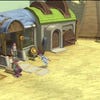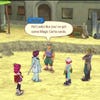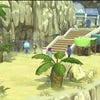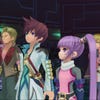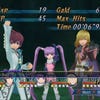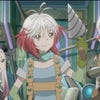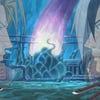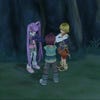Tales of Graces F Review
Sheer arte attack.
Like so many other entries in Namco's long running yet still relatively obscure JRPG series, Tales of Graces F often hides its light under a bushel. An HD makeover of a 2009 Wii game that never saw a western release, it does a great job of following the broad strokes of its genre, but it can take ten hours or more before the ingenious little curlicues that it doodles in the margins take centre stage.
To begin with, however, it's easy to be misled into thinking that it's business as usual. There's a cheesy power pop anthem over the intro sequence, all manufactured uplift and X Factor warbling. There's Asbel Lhant, our tousle haired hero, whose rebellious streak keeps landing him in trouble with his disapproving father, the lord of a dazzlingly colourful, whimsically sketched kingdom. There's a girl who appears out of nowhere, all amnesia and unfeasibly long purple pigtails, her slightly autistic demeanour an obvious prelude to a display of amazing supernatural power.
The gameplay in this early introductory stretch is limited and frankly a bit dull. The characters are all ten years old, and the narrative follows Asbel as he gets into one scrape after another. Enemies are simple monsters, and you beat them up with a wooden sword. There's absolutely no freedom to roam, as the game blocks off every path but the correct one with unapologetic invisible walls.
Holding down L1 brings up your current objective, but this is often incredibly vague. "Head to the capital, Barona" reads one, offering no advice on where Barona may be or which of the various roads in the game will lead you to the port that will take you there. You just have to use trial and error, following every path until you get turned around.
It's a chore, to be honest, and while the story has charm to spare it's a real endurance test getting through this claustrophobic and elongated tutorial.
Four or five hours in, however, Graces begins to live up to its name and starts to reel you in. There's a terrible event that you'll see coming a mile off. We skip forward in time, and find Asbel has grown up into a trainee knight, apparently wearing a costume inspired by Elvis in his Vegas years.
In an instant, the game switches from slightly mawkish childhood yarn into something more melancholy. Plenty of JRPGs hinge on lifelong friends being tugged in opposite directions by events too large for them to control, but by immersing you in Asbel's childhood for so long - even with its irritating construction - the depth of character available to Tales of Graces is amplified tenfold. When one of the characters looks back fondly on the day the gang all went to a meadow overlooking the sea, it hits a little harder because it's referencing more than just another cut-scene that you sort of paid attention to.
That narrative depth only becomes more impressive as the game rolls on past the 20-hour mark and heads towards 30. There's a pleasingly organic flow to the story, the changes always driven by things the characters do, and devoid of the obvious villain roles that the JRPG genre relies on so often. Allies become enemies, enemies become allies, but it happens with greater verisimilitude than usual. Namco Tales Studio has taken the predictable story beats from a dozen other games and made them feel fresh again.
Also deepening over time is your understanding of the game's core mechanisms, and it's here that Graces deviates most ingeniously from expectations.
The crafting system - known as Dualizing - is one such feature. At both shops and wandering merchants known as Turtlez you can combine items together to create something new. Where food is concerned, the results are fairly obvious.
Weapons are another matter. Any weapon or costume can be combined with shards - left behind by defeated monsters in battle - to add status effects. After being used in a combat for a while, this weapon then becomes tempered and can be dualized with another tempered weapon. This returns each weapon to its base state, albeit with a residual increase in stats, and creates a crystal in the process, bearing traits from both weapons. Crystals can be equipped in a separate inventory slot to add more status effects to a character, but can also be dualized further, creating A, B, C, D ranks and beyond, an evolutionary rabbit-hole of character development.
The effect this has on the game is subtle but notable. New weapons are scarce, restricted to tougher base models of each characters chosen arsenal. Iron swords are replaced by steel, and so on, but what really matters is how you grow and evolve that weapon over the course of the game. It also means that you have greater control over the build of your characters, albeit in a slightly removed way. Characters still level up with XP, but this is side-lined to a hilarious degree. You likely won't know or care what level a character is, just so long as their maximum health keeps going up.
Combat is where the game gets really interesting. The Tales series has always had its own approach to this side of the genre, eschewing the turn-based fighting of most rivals for a more hands-on real time system based around "arte" special attacks, but here it takes full flight.
Combat in Tales of Graces takes the form of a complex overlapping web of different systems, which start with Titles. Essentially nicknames, earned through story progression or in-game action, each Title has five tiers to unlock by earning Skill Points in battle, with each tier giving you a new Arte or some increase in combat statistics. The skills and benefits earned are usually - though not always - retained when you swap to a new Title so, much like the weapon crafting, it's a relentlessly progressive system where you're constantly looking for the next upgrade path to develop.
"Once you're over the hump of that rather lumpen introductory section all these different systems interlock, producing a powerful gravitational pull."
In the actual battles, it's all about the Artes. There's no mana reserves here, only Chain Capacity - a much smaller pool that refills when not in use. The more CC you have, the more moves you can chain together before having to block and evade. Consistent hits fill a meter leading to Eleth Bursts, in which you can pull off unlimited Arte attacks for a short time. The effect is to make enemy encounters much faster, with most fights lasting less than thirty seconds. It's both more visceral and more exciting than the time-limited menu battles of most JRPG rivals.
The more Artes you learn, the more the fights open out until they have the intensity and pace of a Namco fighting game rather than an RPG. With four powered-up party members in full flow, later battles are frankly insane - a dizzying riot of outrageous special moves that can be hard to keep track of. Thankfully, for those who can't keep pace with the fighting, there's an option to have battles unfold automatically. You set each characters behaviour model, and then leave them to it. It works too, with characters responding intelligently to what's happening, dodging, healing and choosing attacks based on enemy weaknesses. RPG devotees may consider this heresy, but it's an intriguing way to play.
Once you're over the hump of that rather lumpen introductory section all these different systems interlock, producing a powerful gravitational pull. You're always after that new shard to improve and temper your favourite weapon, or looking to max out a new title and earn a powerful Arte. Those mechanical compulsions mesh with the enjoyable story to create an experience that draws you in on multiple levels.
The decision to follow a smaller personal narrative about friendship rather than vast evil empires and ancient prophecy helps enormously in this regard. Those elements are here, of course, but the characters are never left behind by the script's ambition. The English translation and voiceover is also superbly handled, though die-hard genre fans may lament the lack of a subtitled Japanese option.
Visually, you can sometimes see the sharp edges of the Wii original poking through the HD covering the PS3 provides, but it's not enough to dim the appeal of what is a very attractive game. Locations are short on interaction but visually rich with a painterly charm. Character designs, meanwhile, sail close to JRPG cliché without being overwhelmed by it - pouches and buckles are kept to a minimum.
So while it may look like every other Japanese role-player from a distance, and while that perception endures for the early going, Tales of Graces is very much its own beast in the long term, even as it draws inspiration from the genre's best.
The combination of earnest melodrama, goofy slapstick and outright weirdness (you can equip a watermelon on your head for no reason) give it a light and breezy feel closer to the likes of Final Fantasy 7 and Dragon Quest 8 than the rather pompous direction recent genre outings have favoured. Meanwhile, with its limiting and linear environments and leftfield gameplay mechanics, it also calls to mind such forgotten cult favourites as Dark Cloud.
Tales of Graces f never fully abandons the slight clunkiness of its first few hours, but players who bow out early because of its linear design and apparently limited scope will be missing out on what may well be one of the last great traditional Japanese role-playing games. It may have taken three years for it to reach European shores, but it's well worth the wait.









